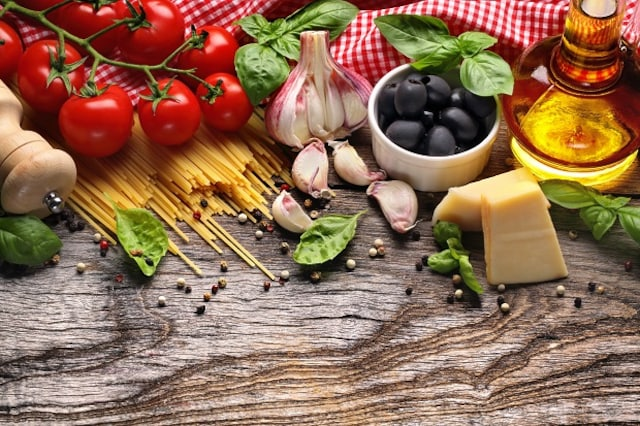A guide to how to pick and how to cook one the world’s most popular cuisines
Italian food is not just about pizza and pasta. Within Italy, there are diverse styles of cooking – South Italy food is dominated by tomatoes, olive oil and pasta while in North Italy, the most commonly used ingredients are alpine cheese, meat. While pasta, sauces, and cheeses are staples across the country, every region has its own unique ingredients and dishes.
It’s a myth that Italian food is all about pizza and pasta, says Amit Rana, GM Holiday Inn New Delhi, Aero city- a hotel which is about to launch an Italian restaurant L’Osteria Bella. He says another myth is that Italian food is primarily about unhealthy or junk food. Says Rana, “It depends on what you eat. You can have lots of veggies like spinach, beans, peas, even bottle gourd in your main course dish or even make a complete meal out of soups and salads. Italian cuisine is very palatable to Indian customers. Ours is not a bow tie restaurant where you have to put a tuxedo to dine there. Instead, it’s a casual family focused bright vibrant place to go and enjoy and have a good time. Even the food will be designed to a local palette. If you give proper Italian Risotto, the customer in India will say you have given me uncooked rice. We have to adapt the cuisine according to our Indian customer.”
Eating an Italian meal is much like a ritual: a gathering of food and family. And most of the culinary traditions are passed down from one generation to the next.
Aseem Grover who runs a popular Italian café The Big Chill in Delhi shares that “the primary thing about Italian cuisine is its sheer simplicity. If you get a good olive oil and a good sea salt, and just a little bit of balsamic vinegar, that is enough to make an outstanding salad. We make every single thing fresh from scratch on site.” He says Indians love Italian food and that is evident from the size of their menu. Says Grover- “We started 22 years ago now when we had an A4 Sheet printed on one side for the menu. But now we have a menu more like a telephone directory. Pasta is always a bestseller but then people love the pizza, grilled food, our bakes, risottos. Plus, we have 15 salads on the menu and one can come and just have a salad menu. Now we find it very difficult to take things off the menu and people love that variety.”
Get Your Ingredients Right
One of the biggest mistakes people make is not using the right tomato sauce for their pizza, or the perfect oil for their food. The use of top-notch ingredients contributes to the overall quality of the food. Italians are crazy about pasta sauces and pesto is one of the most famous pasta sauces. It’s rare for Italians to buy their pasta sauces: it is advisable to make them at home as the recipes are quite simple. If you really want to master your Italian food, you need to use olive oil and, even better, extra virgin olive oil and you will soon notice the difference. While olive oil is often used in cooking, higher quality extra virgin olive oil is used as a garnish to add a peppery flavour. It is also used as a dip for Italian bread like focaccia or drizzled over salad. Olives are another great cornerstone of the Italian menu. True balsamic vinegar is a dark, well-aged vinegar used in marinades and dressings. Garlic is one of the most popular ingredients throughout the country, especially sautéed in olive oil to create a flavorful cooking base. Dried mushrooms are another ubiquitous ingredient in Italian cuisine. Basil is a fragrant green herb with a smoky, minty taste, and the most popular herb in Italian cooking.
Cheese is an important part. Popular varieties include Parmigiano-Reggiano from Parma in the Emilia-Romagna region and Grana Padano from northern Italy. Pecorino are cheeses made from sheep’s milk. A soft cheese like mozzarella is used to melt over meals, like lasagna and pizza.
Pastas, which is generally a mix of flour, eggs, olive oil, water, and salt, are a big hit with Indians. Flour is fundamental in Italian cuisine: it’s used for everything and for this reason it has to be of very high quality. There are many varieties of pasta based on the shape and the region they are from. Popular types include spaghetti (long, thin strands of pasta); penne (tube shapes from Liguria); tagliatelle (thin pasta ribbons from Bologna); fettuccine (long, flat pasta from Rome); and pappardelle (flat, wide pasta ribbons from Tuscany).
Tips and Tricks
The heart of Italian food is its ingredients. Take the case of Chef Vanshika Bhatia, Head Chef and Co-founder OMO Café in Gurugram who gets most of her ingredients from the hills in Uttarakhand and believes in serving hyperlocal and hyper seasonal vegetarian Italian food. She shares that they make their own pastas from the dough and everything else. Some of their specials at her restaurant include eggless Pastas, roasted cauliflower Aglio Olio Pepperoncini, mushroom, lime and garlic, mushroom and cauliflower Bolognese. The pizzas are St. Louis Style Pizzas known for the paper-thin crispy crust and the tangy sweet sauce which is heavy on oregano and there are herbed vegetables and bocconcini, wild Mushroom and goat cheese, spinach, sundried tomato and feta.
Says Chef Bhatia- “Italian cooking is about a lot of fresh ingredients. The best food I have had was in Italy where I could taste the actual flavour of the ingredient. Like even if I am having the pasta I can taste the dough, the tomato, the cheese – everything separately and it all just marries well together – that is the main thing. It needs to be fresh cooking. You can’t just make it and keep it. We make fresh pastas almost every day and we don’t dry them .. we just blanch them and serve them to order. Besides, you need to choose your tomatoes really carefully – they need to be real plump and they can’t be too sour or too sweet. Your olive oil needs to be really good.” She alerts that Indians want overcooked pasta with lots of chilly flakes and fried garlic. “You have to put in garlic, but it should not be overfried. You can use some olives and onions as they surely enhance and bring out the flavours of your Italian dishes. Fresh herbs are much better than dried herbs in a bottle. You can get fresh leaves such as basil, thyme, and rosemary in your local market such as INA market in New Delhi. You may start cooking with Pomace olive oil. But you can dress the final dish with extra virgin olive oil and adding some freshly crushed pepper on top can be helpful.”
Finally, Italian food focuses more on extracting the most essence of each ingredient, instead of the spices. Much like Indian food, Italian food is a culture, not just a cuisine.
|
Ingredient |
Price |
|
Pasta |
138-200 per kg |
|
Cheese |
345-500 per kg |
|
Maida Flour |
20-45 per kg |
|
Olive |
250-500 per kg |
|
Oregano |
199 for |
|
Italian |
125- |
|
Pasta |
170-250 |
|
Olives |
150-400 per kg |
|
Balsamic |
99 for |
Source: Market Research




